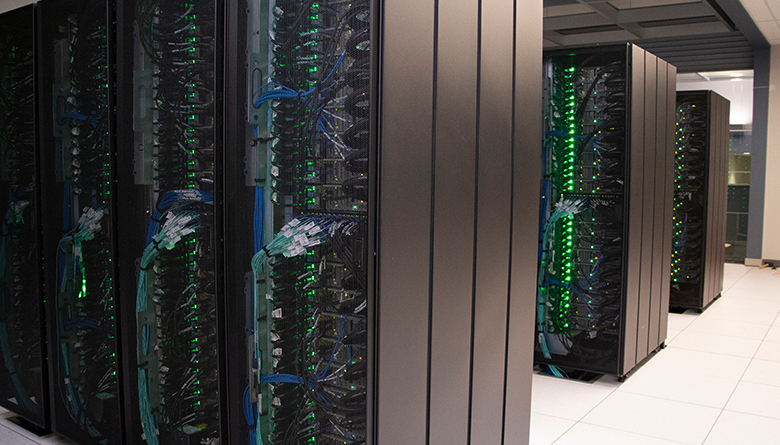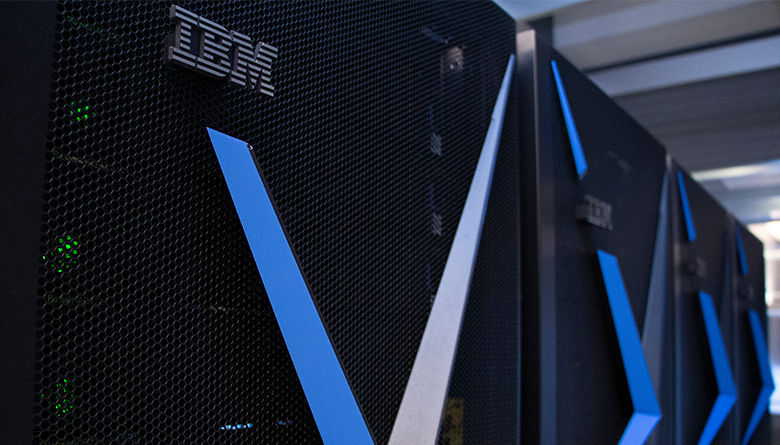Contributors: Reeve Hamilton and Mary Martialay
One of the most powerful new supercomputers in the world — and the most powerful supercomputer in New York state — was recently installed at the Rensselaer Polytechnic Institute Center for Computational Innovations. Part of a collaboration between Rensselaer, IBM, and New York state, it is configured to enable users to explore new AI applications and accelerate economic development from New York’s smallest startups to its largest enterprises.
Here is everything you need to know about the machine, which is named AiMOS (short for Artificial Intelligence Multiprocessing Optimized System), and how it fits into the research ecosystem at Rensselaer and beyond:
Quick Facts
According to the November 2019 Top500 and Green500 supercomputer rankings, AiMOS is the…
- #1 most powerful supercomputer housed at a private university;
- #1 most energy efficient supercomputer in the U.S. (#3 in the world);
- And the #24 most powerful supercomputer in the world.
How was AiMOS built?
Built using the same IBM Power Systems technology as the world’s smartest supercomputers, Summit and Sierra, AiMOS uses a heterogeneous system architecture that includes IBM POWER9 CPUs connected to NVIDIA GPUs with the industry’s only CPU-to-GPU NVIDIA NVLink interface, which increases GPU memory bandwidth up to 5.6x.
How powerful is AiMOS?
AiMOS can deliver sustained performance of 8 petaflops. It has a peak performance of 12 petaflops.
What are petaflops?
FLOPS are floating-point operations per second. A floating-point operation is any mathematical operation that involves floating-point numbers, which are numbers that have decimal points in them. A petaflop is the ability to do 1 quadrillion — or one thousand million million — FLOPS.
Is there an easier way to explain 8 petaflops?
You could say that, in order to keep up with AiMOS, each of the roughly 8 billion people on our planet would have to perform 1 million calculations per second.
Why is it called AiMOS?
Amos Eaton, the co-founder and first senior professor at Rensselaer, has historically been the namesake of supercomputers at the Institute. While continuing to honor his legacy, the name has been tweaked slightly for this new machine to reflect its specialized configuration to enable advances in artificial intelligence research.
How does AiMOS compare with previous supercomputers at Rensselaer?
AiMOS is roughly 10 times more powerful than its immediate predecessor, the Blue Gene system named AMOS, and about 120 times more powerful than the first Rensselaer Blue Gene L supercomputer, activated 12 years ago.
How will AiMOS be used?
AiMOS will serve as the test bed for the New York State-IBM Research AI Hardware Center. A partnership between Rensselaer, IBM, and New York state, the AI Hardware Center is advancing development of computing chips and systems that are designed and optimized for AI workloads and are pushing the boundaries of AI performance. AiMOS will provide the modeling, simulation, and computation necessary to support the development of this hardware.
AiMOS will also be accessible to collaborators from IBM Research, SUNY, and other public and private industry partners. It will also be used by Rensselaer faculty, students, and staff engaged in ongoing research collaborations that employ and advance AI technology, many of which involve IBM Research. These initiatives include the Rensselaer-IBM Artificial Intelligence Research Collaboration, which brings researchers at both institutions together to explore new frontiers in AI; the Cognitive and Immersive Systems Lab; and The Jefferson Project, which combines Internet of Things technology and powerful analytics to help manage and protect one of New York’s largest lakes, while creating a data-based blueprint for preserving bodies of fresh water around the globe.





